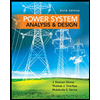3. Determine the currents I, I2, and I3. Then construct a phasor diagram to show that I + l2+ Iz = 84(-30°). 8L38 A jran
3. Determine the currents I, I2, and I3. Then construct a phasor diagram to show that I + l2+ Iz = 84(-30°). 8L38 A jran
Delmar's Standard Textbook Of Electricity
7th Edition
ISBN:9781337900348
Author:Stephen L. Herman
Publisher:Stephen L. Herman
Chapter29: Dc Generators
Section: Chapter Questions
Problem 5RQ: What are interpoles, and what is their purpose?
Related questions
Question

Transcribed Image Text:### Electrical Engineering Problem: Circuit Analysis
#### Problem Statement:
3. Determine the currents \( I_1 \), \( I_2 \), and \( I_3 \). Then construct a phasor diagram to show that \( I_1 + I_2 + I_3 = 8 \angle (-30^\circ) \).
#### Given Circuit Description:
- The circuit consists of a parallel configuration.
- There is a current source supplying \( 8 \angle 30^\circ \) amperes.
- Three branches are connected to the source:
- The first branch contains a resistor with a resistance of \( 5 \Omega \).
- The second branch contains a resistor with a resistance of \( 2 \Omega \) in series with an inductor modeled by an impedance \( j10 \Omega \).
- The third branch contains a resistor with a resistance of \( 6 \Omega \) in parallel with a capacitor modeled by an impedance \( -j2 \Omega \).
#### Graphical Representation:
The diagram shows the following components and their connections:
- To the far left is the current source labeled \( 8 \angle 30^\circ \) A with an arrow indicating the direction of current flow.
- In parallel:
- The first branch is marked by a resistor \( R = 5 \Omega \) with current through it labeled \( I_1 \).
- The second branch has a series connection of a resistor \( 2 \Omega \) and an inductor \( j10 \Omega \) with current through it labeled \( I_2 \).
- The third branch has a resistor \( 6 \Omega \) in parallel with a capacitor \( -j2 \Omega \) with current through it labeled \( I_3 \).
#### Analysis Required:
1. Perform calculations to find the values of \( I_1 \), \( I_2 \), and \( I_3 \) using complex impedance analysis.
2. Verify that the sum of the phasor currents \( I_1 \), \( I_2 \), and \( I_3 \) is equal to the source current \( 8 \angle -30^\circ \) A.
3. Construct a phasor diagram to visually demonstrate the relationship.
#### Steps to Solve:
1. Calculate the impedance of each parallel branch.
2. Use Ohm's Law (\( V = IZ \)) to find the voltage
Expert Solution
This question has been solved!
Explore an expertly crafted, step-by-step solution for a thorough understanding of key concepts.
This is a popular solution!
Trending now
This is a popular solution!
Step by step
Solved in 3 steps with 5 images

Knowledge Booster
Learn more about
Need a deep-dive on the concept behind this application? Look no further. Learn more about this topic, electrical-engineering and related others by exploring similar questions and additional content below.Recommended textbooks for you

Delmar's Standard Textbook Of Electricity
Electrical Engineering
ISBN:
9781337900348
Author:
Stephen L. Herman
Publisher:
Cengage Learning

Power System Analysis and Design (MindTap Course …
Electrical Engineering
ISBN:
9781305632134
Author:
J. Duncan Glover, Thomas Overbye, Mulukutla S. Sarma
Publisher:
Cengage Learning

Delmar's Standard Textbook Of Electricity
Electrical Engineering
ISBN:
9781337900348
Author:
Stephen L. Herman
Publisher:
Cengage Learning

Power System Analysis and Design (MindTap Course …
Electrical Engineering
ISBN:
9781305632134
Author:
J. Duncan Glover, Thomas Overbye, Mulukutla S. Sarma
Publisher:
Cengage Learning